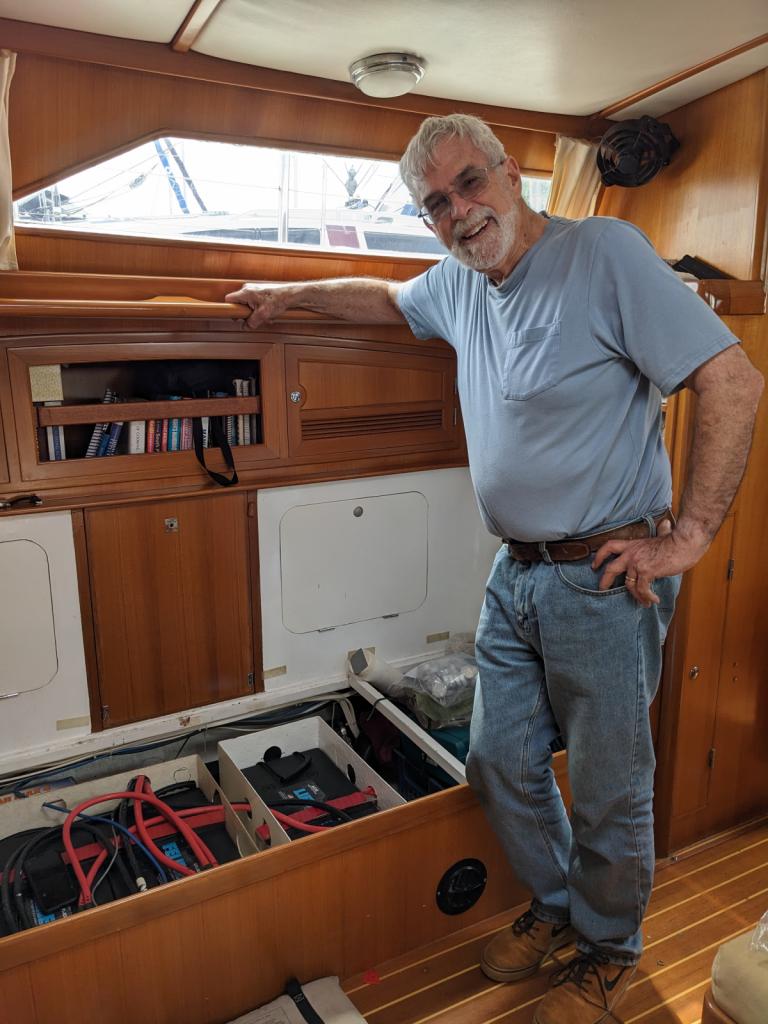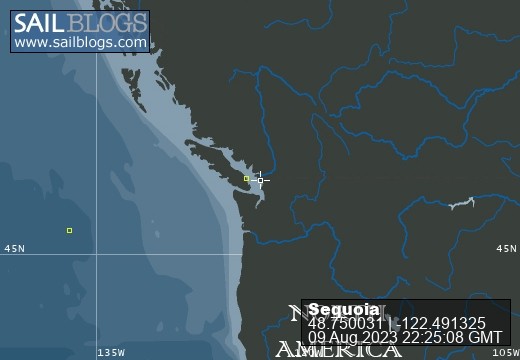
Sequoia Changing Latitudes
30 August 2023 | St. Helens, Oregon
09 August 2023 | Bellingham, Washington
21 July 2023 | Boat: Bellingham; C&B: Scappoose
10 July 2023 | Egmont, Sunshine Coast, B.C., Canada
02 July 2023 | Walsh Cove, Desolation Sound, B.C., Canada
23 June 2023 | Westview/Powell River B.C.
18 June 2023 | Ganges, Saltspring Island, B.C., Canada
22 June 2019 | Scappoose, Oregon
27 May 2019 | Back home in Oregon
09 May 2019 | Villas Alturas Hotel, Costa Rica
02 May 2019 | San Vito, Costa Rica
23 April 2019 | Golfito, Costa Rica
11 April 2019 | Panama City, Panama
04 April 2019 | Shelter Bay Marina, Colon, Panama
22 March 2019 | Jamaica
11 March 2019 | Zar Par Marina, Boca Chica, Dominican Republic
18 February 2019 | Culebra Island, Puerto Rico
31 January 2019 | Simpson Bay Lagoon, Sint Maarten
21 January 2019 | Nelson's Dockyard, English Harbour, Antigua
04 January 2019 | Portsmouth, Dominica
Göta Canal
03 August 2017 | Motala, Sweden
Barbara/cloudy but warm

Wow, I've let 10 days go by since our last blog post, and so much has happened. We are now about half way across Sweden (traveling east to west), using the Göta Canal and the network of central Sweden lakes. Last time I wrote, we were entering the Stockholm archipelago - such a distance and such a change of scenery from then to now!
Our first stop in the archipelago was Stämmarsund, a small harbor with space for perhaps three boats. By the evening, there were 7 or 8 boats - 4 or 5 of them were rafted together, like the petals of a daisy around the end of the dock.
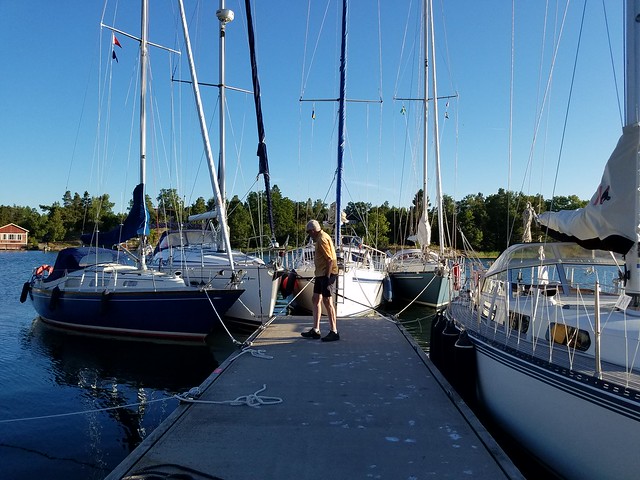
Right next to the public dock was the ferry dock. We watched the ferry come and go at least twice during that afternoon and evening. The passengers stand on the concrete quay, rotate a sign to indicate they want to board, and the ferry noses right up to the quay, stopping no more than 30 seconds for the passengers to board through an opening in the bow of the boat.
A fellow from one of the other boats told Craig that the harbormaster was up in the yellow house, where there is also a restaurant. Fern and I decided to go up, pay for moorage, and find out about the restaurant. It turned out we missed the part of the description where the fellow had pointed the direction of "the yellow house". So yellow is one of the favorite Swedish colors for summer houses (second only to red). We could see one yellow house from the dock, so we headed to it. The path was somewhat overgrown (I was thinking this is unlikely for a restaurant) but we headed to the front door, which was standing open. A dog started barking at us, and the dog awoke the woman who was asleep in the living room. Needless to say, this was not the harbormaster. However, she pointed south toward what she said was "the yellow house."
It turns out of course that there were three yellow houses in a row, and the harbormaster/restaurant was in the third one. Fortunately Fern and I decided to keep walking until we saw the restaurant sign.
That evening we all headed up to the restaurant for dinner. It was a simple menu, but of course at breathtakingly high prices. We arrived there at about the same time as a party of about 30 (family reunion?) Fortunately it turned out they had pre-ordered so there wasn't the crush on the kitchen we had feared.
The next day we decided to head for Sandhamn which was a good location for Mark and Fern to catch a ferry back to Stockholm to continue with the land portion of their European trip. The book said that there are 350 guest berths at Sandhamn, so it seemed like we ought to be able to find space. Of course it turned out that the reason there are 350 berths is because there is that much demand. We arrived at midday, and there were about 8 boats circling around the narrow approach channel. There was a young man in a gästhamn dinghy, attempting to find slips for all the boats. In the wind it was a lot of work to avoid the other boats. The young man, clearly quite desperate, finally assigned us a slip. As we've experienced in the past, there is an expectation that every sailboat our size will have bow thrusters. We do not. Therefore, getting to the assigned slip was an impossibility. We all looked at each other and agreed to go on and find another island with a ferry connection to the mainland.
We looked at charts, guides and the ferry schedule, and settled on the island of Namdö where there were several good anchoring possibilities, plus a good ferry connection. There was lots of traffic through the islands, but only a few boats anchored at Namdö. We passed by the ferry landing to make sure it would be possible to land Mark and Fern there (it would be), and then found a nice anchorage nearby. We settled in, had a nice dinner on the boat and watched what would be Mark & Fern's last session with one of the "Jeeves and Wooster" episodes we've been watching.
The next morning we were able to dock at Namdöböte at a ferry landing much like the one we had seen at Stämmarsund. Mark and Fern reported to us later that morning that they had successfully caught the ferry and were heading toward the land-based attractions they had lined up for the rest of their Baltic trip.

We headed toward Nynäshamn (we had stopped there on the way north) and once again enjoyed the smoked salmon dinner at one of their shoreside restaurants. From there it was on to Oxelösund, one day away from the entrance to the Göta canal. Oxelösund is a town that is quite industrialized, without some of the historical sites and tourist attractions that draw the crowds in other places. So the marina tries extra hard, with high quality facilities (best laundry we've seen so far) and some services not offered elsewhere (bikes to borrow for free and a free bus to the center of town). All at a lower price than most other marinas. We had heard about the nice Oxelösund facilities from another boater in Nynäshamn, so obviously word of their low prices and nice facilities is spreading.
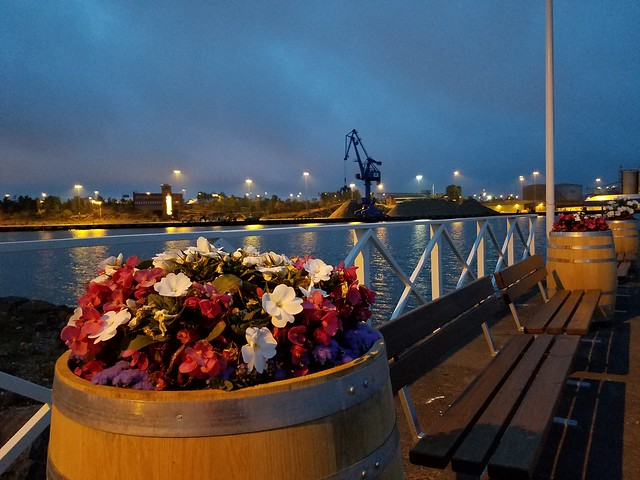
Above: Nighttime view from the Oxelösund guest harbor towards the port's industrial facilities.
Cori Kosyna and her 6 year old son Finn came to us by train and bus in Oxelösund. They would spend the next 12 days with us, including much of the transit of the Göta canal. We pushed off the next morning, and were at Mem, entrance to the canal, by midday.
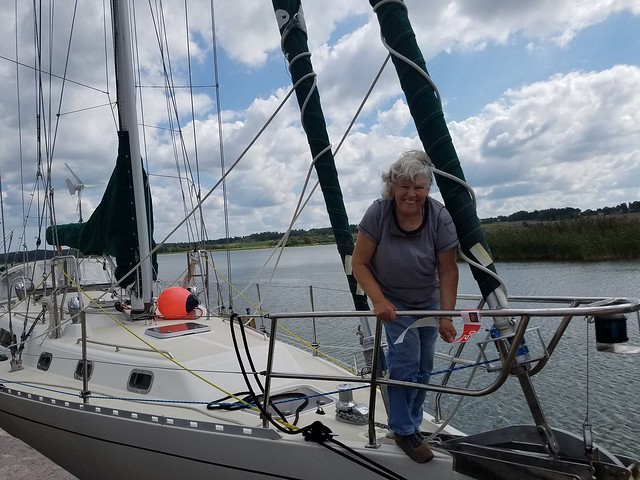
Above: At Mem, affixing the boat's "passport" for the Göta canal.
Below: In the first lock.
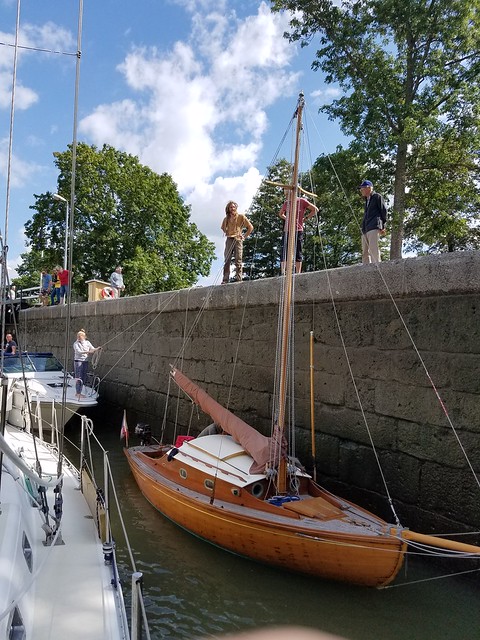
After registering and receiving our tags, stickers and access cards, we entered the first lock. Cori and Finn have been through the Göta canal before, so they were able to offer good advice about how to do it. We've been learning gradually; we've now done 37 locks and are getting a bit better at it.
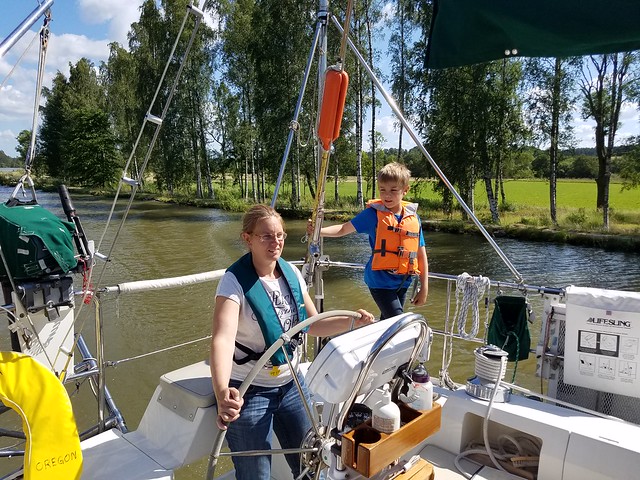
Above: Cori and Finn aboard Sequoia in the first portion of the canal.
The first section of the canal, from Mem to Söderköping included only three locks over the space of three miles. The lock tenders are enthusiastic young people, all in yellow shirts, dark blue shorts and life vests, shoulder radios and carrying a bright orange control for their particular lock. Many are experienced and can offer good advice to newbie lock users like us. Others are learning on the job.
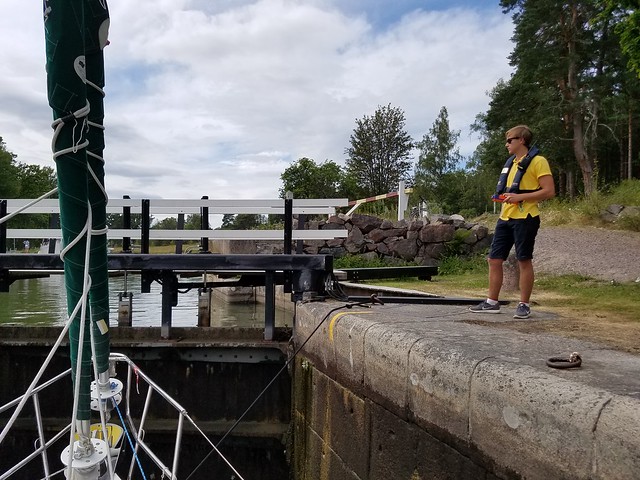
Above: A Göta canal lock tender.
Söderköping is a delightful town up against a cliff. The canal runs along the base of the cliff, and the town lies to the south. There are charming old streets and squares and a medieval church with a separate wooden bell tower standing alongside. We found a restaurant in the main square that was charming and made delicious food. After he ate, Finn ran laps around the square. I guess he doesn't get enough exercise on the boat! After dinner we found an old fashioned Swedish phone booth (no longer equipped with any phone). Craig and Finn pantomimed phone calls in the booth (see photo at the top of this page).
The canal is seemingly the main attraction for the thousands of tourists who come by bus and car to the town. At first we tied up at one end of town where the only tourist traffic was the walkers who wanted to hike a section of the canal's tow path. But later we moved to a better berth nearer the center of town, and those thousands of tourists walked right past our boat. At least a hundred of them asked if we had sailed all the way from America. (Perhaps I exaggerate, but not by much.)
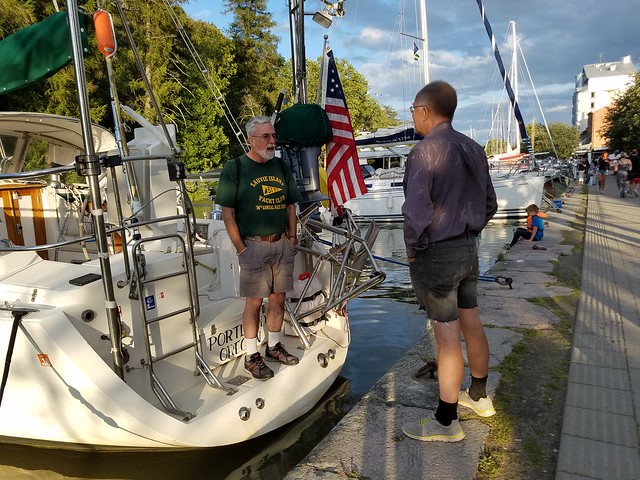
We hiked up the cliff on the south side of Söderköping - 305 steps up to the viewpoint, which did indeed offer a spectacular view.
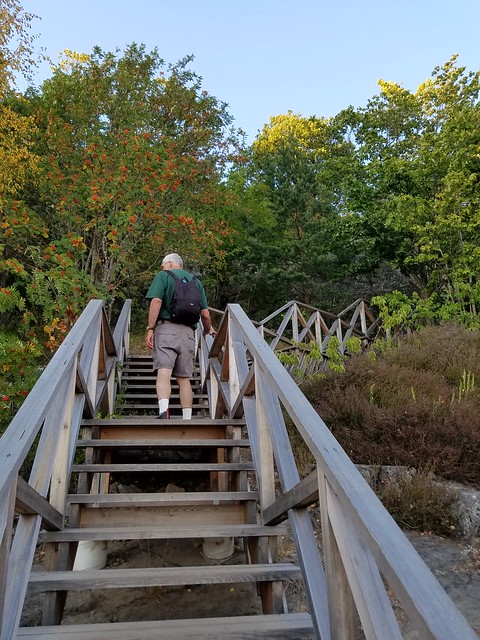
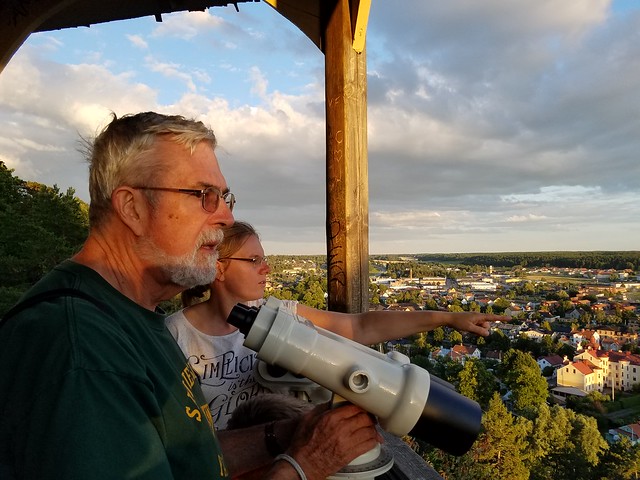
We considered standing in line for an ice cream cone at the famous stand (the attendant at the gas dock in Oxelösund had told us we must do that - "best thing in Söderköping"), and obviously hundreds of tourists had heard similar advice because the line was more than a block long. The owner of one of the restaurants in town came around to each boat to talk up the tapas, gins and tonics at his restaurant. The owner of another restaurant - who turned out to be an American who had last operated a restaurant in Everett, Washington - came around to find out about the American boat (we still have seen only two other boats with an American flag). His visit was very timely, because we had just discovered that our refrigerator/freezer had seemingly bit the dust, and he was able to offer us advice about refrigeration technicians in the area, as well as a good helping of ice out of his restaurant's ice machine.
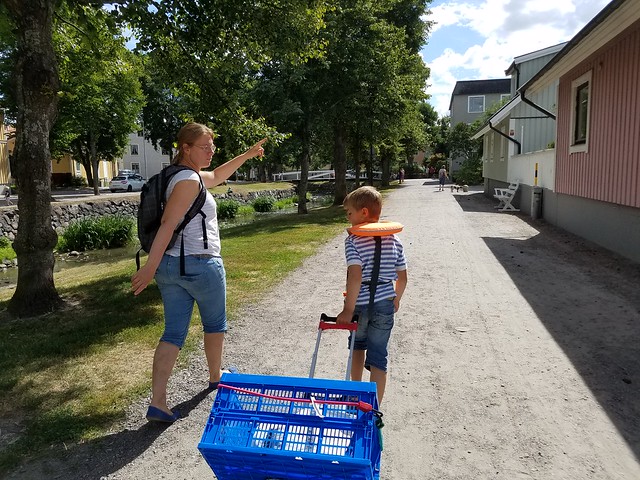
Cori, Finn and I set out for the grocery store to see if anyone was selling block ice (they weren't) or even several bags of cube ice (which we did find). By the next morning, Craig was able to determine that the source of the problem was a faulty relay, and eventually he was able to devise a work-around that involves removing or replacing the fuse several times a day and occasionally hitting the control box. (Craig's a very clever engineer. I don't ask, I just do. It seems to work.) We now have some replacement relays coming, thanks to Chip Gardes who found them on Craig's electronics bench at home and is mailing them to us, c/o Henrik & Tina Olsson, whom we we will be visiting in Göteborg about a week from now. (Long supply pipeline!) (Henrik and Tina are also serving as our maildrop for some rigging parts from England, a shower repair kit from the US - via our son, Ian and former exchange student Jürg Buschor - and more relays from Poland.) (Thanks to everyone assisting our supply pipeline!)
Nick, the American restaurant owner in Söderköping who helped us with the ice, warned that there would be loud reggae music from his canal-front restaurant that night. He said that usually, on reggae nights, people are 10 or 20 deep in a circle around the restaurant, which would likely put them all the way back across the boardwalk to our boat. Fortunately there weren't quite as many listeners as he had predicted, and things did quiet down by 11 pm. (The reggae musicians were quite good, by the way.)
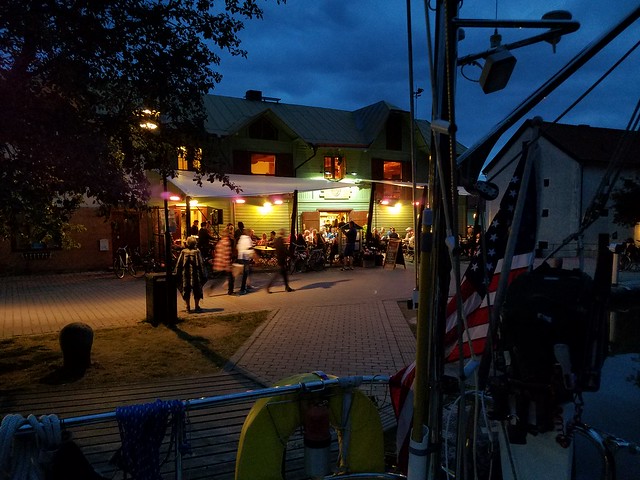
Above: The late-night view, from Sequoia, of the restaurant and the reggae musicians.
We continued along the canal, transiting locks and bridges. We began to see dates carved into the stone lip of the lock - at first we saw 1826, then as we traveled westward the dates were earlier and earlier. Yesterday we saw 1818. (We have learned that the canal was constructed from west to east, hence the earlier dates on the western side.) Somehow I find these date stones to be so impressive - to think that something constructed 200 years ago, a fairly sophisticated infrastructure, is still in use, by us, today.

There are many bridges along the route. Some are major roads, and others are little-used byways. When we approach each bridge, there is a traffic light telling us whether to stop (blinking red; they don't see us yet) or slow way down (blinking red and white - they have seen us but are not ready for us) or go (green). They watch the bridges through cameras and we only rarely see an actual bridge tender.
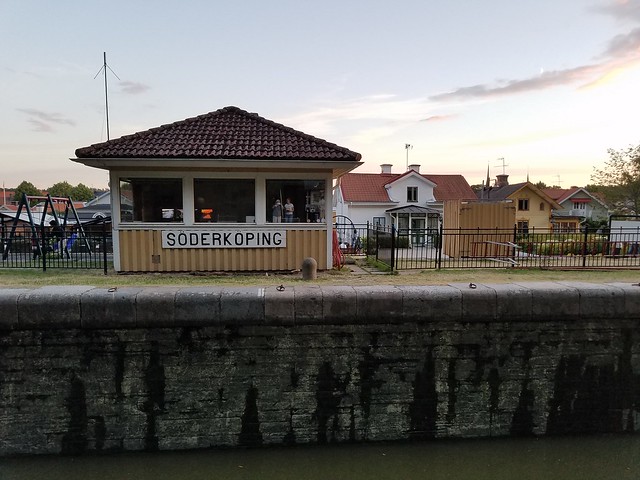
Above: The locktender's house at Söderköping. Look in the left windows and you can see some of the screens that are used to monitor other locks and bridges (the right hand one showing a sunset view). (In the right window, you can see a reflection of Barbara and Cori standing across the lock).
Nearly every bridge, and nearly every lock has a lock tender or bridge tender's house, usually well-maintained and charming, with the name of the lock or bridge prominently displayed on the house. We asked one of the lock tenders whether she got to live in the house. Her response: "I wish!"
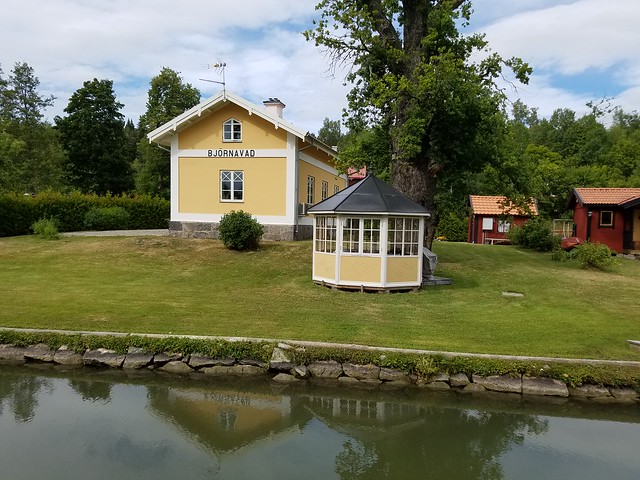
Above: Locktender's house at Björnavad.
The day we left Söderköping, one of the lock tenders told us there was a nice place to pull over for lunch, just after a bridge up the way called Snöfvelstorp (I can't say that name without laughing!) We decided to do that, but before we got to the wall, we were aground. The keel was sunk deep into the muddy bottom. We looked over at the bridge tender's booth, and amazingly enough there was movement in there. Cori said the guy was legs in the air, standing on his head or doing yoga poses perhaps. Once we saw the top part of him we started waving. He came over and offered his sympathy. He radioed back along the path we had come and found a boat willing to give us a tow. We decided to have lunch anyway, 4 feet away from the wall, stuck in the mud. After lunch, Craig made a new effort to break us loose with the motor at full throttle, and was finally successful. The boat willing to tow us was just coming into sight and we struck up a friendship with those folks after that.
As we continued up the canal, subsequent lock tenders knew us as the American boat that had gone aground at Snöfvelstorp. We did learn that this section of the canal is suffering from low water this year. One lock tender told us that in the six weeks she had been on the job she had experienced only 20 minutes of rain. They were no longer allowing the big passenger tour boats to transit that portion of the canal. We didn't see any of the tour boats, in fact, until we got to Borensburg, where two of them were docked and taking on passengers. They are impressively huge, with at least three decks. It was hard for us to imagine how they could get through the locks, although we have now seen that they do.
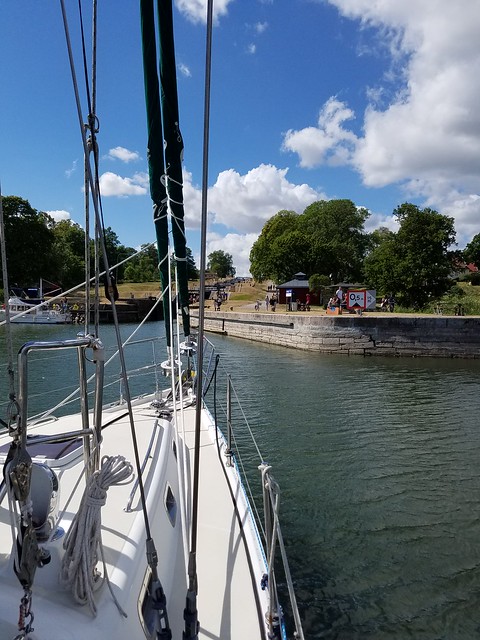
Above: Approaching the flight of locks at Bergs Slussen.
The most famous flight of locks on the Göta canal is the set of 7 consecutive locks called Bergs Slussen. The set of locks is approached from Lake Roxen and can be seen from a long distance away, stepping up the hill. It is here that we found about the true athletic nature of transiting locks. They assign boats to ascend together based on how they will best fit into a lock. Our particular group consisted of Sequoia, a smaller sailboat and a small Gota canal charter boat. The charter boat was being rented by a Norwegian family including two small children who had become good friends of Finn's. They did not share a common language but they had fun dipping nets for fish in the canal and running up and down the docks laughing hilariously.
The smaller sailboat was skippered by a man with limited experience and his completely inexperienced partner. I cannot catalog for you all the mistakes they made, although some of them did get corrected as we worked our way up the flight of locks. The challenge in the locks is that water from the upper lock gate comes furiously at the boat from several directions. The boats are jostled around and are constantly in danger of banging into each other and into the walls of the lock. Each boat is supposed to have lines run to rings on the lock edge to control the boat's movement. Sometimes the boat is too heavy to control manually and winches must be used. (We always use winches on Sequoia's lock lines, but Sequoia is one of the larger and heavier boats on the canal). The lock master and the skipper of a boat don't necessarily agree as to how a boat should be handled. The skipper of one boat certainly does not agree with how the boat next to him is being handled. The inexperienced skipper in the small sailboat next to us certainly did not agree with how we were handling our boat, and he didn't hesitate to let us know.
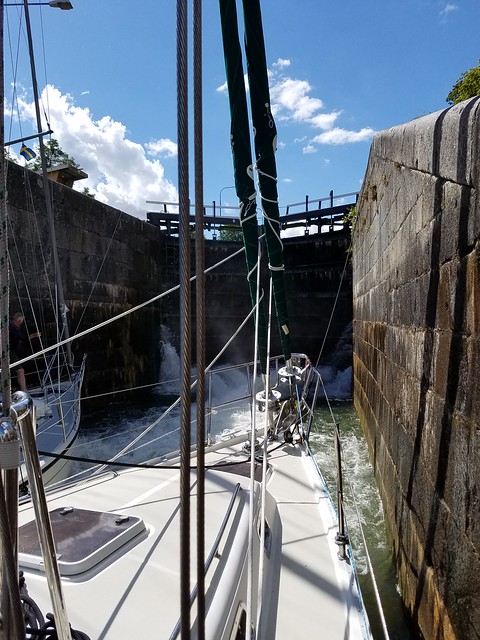
Above: Inside one of the Bergs Slussen locks.
So in addition to the physical work of handling the lines to control the boat's motion, there is the emotional work of dealing with the people on the adjacent boats. When you go through a flight of seven locks, you repeat the same experience seven times. The boats leave each lock and enter the next one in exactly the same order, with none of the previous lock's problems solved. We arrived at the top of the seven locks absolutely wrung out. Then our fender board got caught in a lock gate, snapped off, and we left it floating in the lock. Fortunately, those very nice Norwegian folk in the Göta Canal charter boat were able to capture the wounded fender board and give it back to us.
We found a berth in the basin at the top of the locks and spent the rest of the day unwinding. We even decided to get a late start in the morning, giving Craig a chance to repair the fender board so we could continue to use it to protect our boat from the stone walls of the locks.
Well the late start was a mistake! The basin at the top of the Bergs Slussar turned out to be home base for at least two passenger tour boats. The tour boats have some sort of god-like priority over any other boat. They make a reservation for a particular time slot in a lock (something we can't do), and everybody get out of their way! We got in line for the next two double locks (four locks total) at 11 am, and we didn't move into the first lock until at least 2 pm. After getting out of the fourth lock they told us we'd have to wait at a dock alongside the canal because the fifth lock (a mile ahead) had priority passenger boats coming and going. We were to move to the next dock as soon as it become available when the boats at that dock finally moved into the lock. It was an opportunity for all of us to go swimming and cool down from the heat of the day.
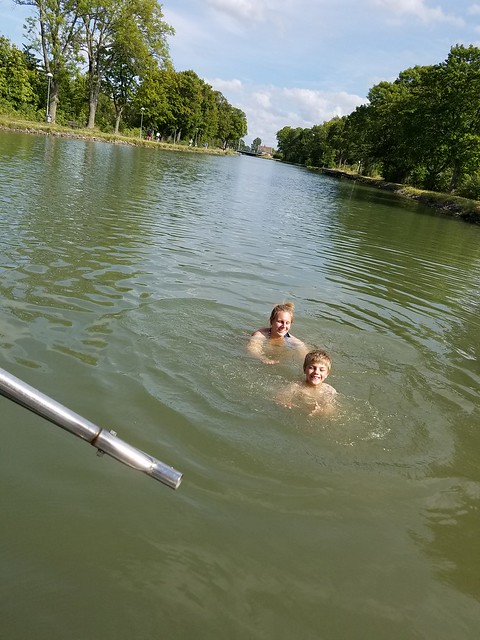
By the time we got out of the next lock, it was 5:15 pm. The lock tender told us that there was an opening bridge at Ljung 45 minutes ahead. They close the whole system down at 6 pm, so we had to find a place to tie up for the night before the Ljung bridge. The one designated marina we passed had no space, and then there were miles and miles of beautiful canal with nowhere to tie up. We finally pulled in to a dock shortly before the Ljung bridge and spent the night there. Whew. Another exhausting day: 5 locks, 7 hours, and only four miles. We could have walked it much faster!
We were accompanied through that day by a Swedish boat named Vera-Linnea. Aboard that boat was a small dog named Tuffay (I'm sure that's NOT the spelling). The owners, Lennart and Linnea, explained that Tuffay means "tough guy" in Swedish.
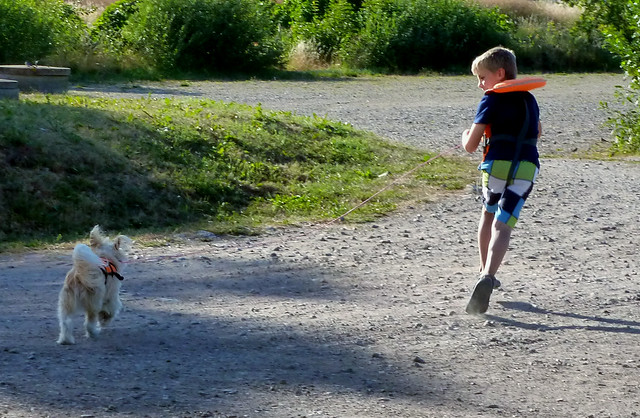
Above: Finn and Tuffay. Photo by Cornelia Kosyna, used with permission.
Finn became best friends with Tuffay, running him all around the locks on a leash, throwing things for him to retrieve and cuddling or petting him. Finn was quite distraught each time Tuffay's boat appeared to go off in a different direction or at a different time. But we always ended up together, cooperating pretty well on our lock-throughs (the two boats are big enough that there is no room for a third boat in the lock).
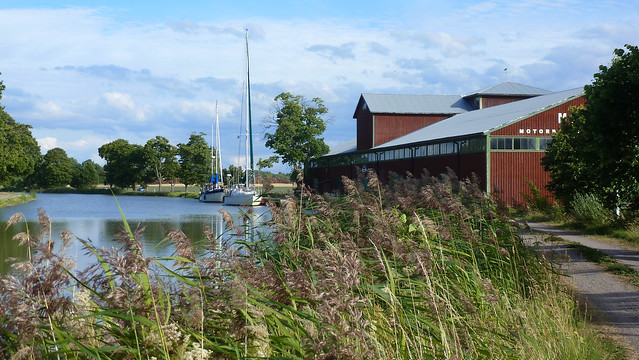
Above: Sequoia and Vera-Linnea at the Musiehuset dock. Photo by Cornelia Kosyna, used with permission.
Vera-Linnea also tied up at the dock before the Ljung bridge, and Finn was able to get in some good dog time. The dock apparently belonged to a "Musiehut" or big museum, which may have housed nautical stuff or farm equipment - hard to tell. Signs proclaimed "free entrance" and "cafe" but everything was closed when we were there. That evening was a gorgeous sunset - a peaceful ending to our short-distance day.
We are now in Motala, and have decreed for ourselves a day of rest. We'll see what there is to see here, stock the refrigerator (still limping along), and get our communications with the outside world (including this blog post) done.
With apologies for this extra-long blog post, we wish you the best, and hope your summer is as fun and interesting as ours!
Click here for photos of our approach to the Göta Canal and the first part of the canal.
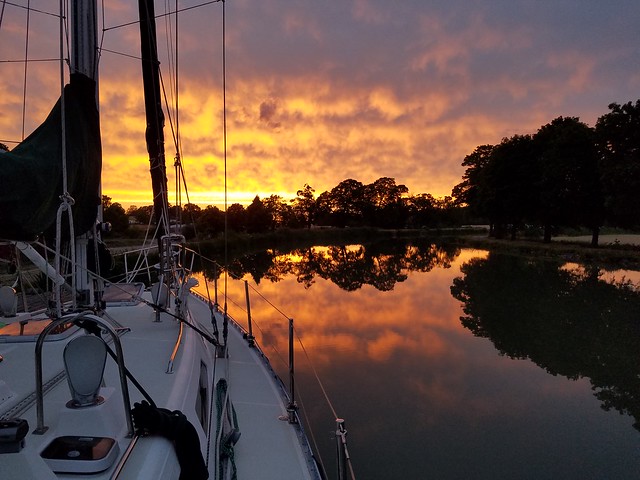
Above: Sunset at the Musiehuset dock.
Our first stop in the archipelago was Stämmarsund, a small harbor with space for perhaps three boats. By the evening, there were 7 or 8 boats - 4 or 5 of them were rafted together, like the petals of a daisy around the end of the dock.

Right next to the public dock was the ferry dock. We watched the ferry come and go at least twice during that afternoon and evening. The passengers stand on the concrete quay, rotate a sign to indicate they want to board, and the ferry noses right up to the quay, stopping no more than 30 seconds for the passengers to board through an opening in the bow of the boat.
A fellow from one of the other boats told Craig that the harbormaster was up in the yellow house, where there is also a restaurant. Fern and I decided to go up, pay for moorage, and find out about the restaurant. It turned out we missed the part of the description where the fellow had pointed the direction of "the yellow house". So yellow is one of the favorite Swedish colors for summer houses (second only to red). We could see one yellow house from the dock, so we headed to it. The path was somewhat overgrown (I was thinking this is unlikely for a restaurant) but we headed to the front door, which was standing open. A dog started barking at us, and the dog awoke the woman who was asleep in the living room. Needless to say, this was not the harbormaster. However, she pointed south toward what she said was "the yellow house."
It turns out of course that there were three yellow houses in a row, and the harbormaster/restaurant was in the third one. Fortunately Fern and I decided to keep walking until we saw the restaurant sign.
That evening we all headed up to the restaurant for dinner. It was a simple menu, but of course at breathtakingly high prices. We arrived there at about the same time as a party of about 30 (family reunion?) Fortunately it turned out they had pre-ordered so there wasn't the crush on the kitchen we had feared.
The next day we decided to head for Sandhamn which was a good location for Mark and Fern to catch a ferry back to Stockholm to continue with the land portion of their European trip. The book said that there are 350 guest berths at Sandhamn, so it seemed like we ought to be able to find space. Of course it turned out that the reason there are 350 berths is because there is that much demand. We arrived at midday, and there were about 8 boats circling around the narrow approach channel. There was a young man in a gästhamn dinghy, attempting to find slips for all the boats. In the wind it was a lot of work to avoid the other boats. The young man, clearly quite desperate, finally assigned us a slip. As we've experienced in the past, there is an expectation that every sailboat our size will have bow thrusters. We do not. Therefore, getting to the assigned slip was an impossibility. We all looked at each other and agreed to go on and find another island with a ferry connection to the mainland.
We looked at charts, guides and the ferry schedule, and settled on the island of Namdö where there were several good anchoring possibilities, plus a good ferry connection. There was lots of traffic through the islands, but only a few boats anchored at Namdö. We passed by the ferry landing to make sure it would be possible to land Mark and Fern there (it would be), and then found a nice anchorage nearby. We settled in, had a nice dinner on the boat and watched what would be Mark & Fern's last session with one of the "Jeeves and Wooster" episodes we've been watching.
The next morning we were able to dock at Namdöböte at a ferry landing much like the one we had seen at Stämmarsund. Mark and Fern reported to us later that morning that they had successfully caught the ferry and were heading toward the land-based attractions they had lined up for the rest of their Baltic trip.

We headed toward Nynäshamn (we had stopped there on the way north) and once again enjoyed the smoked salmon dinner at one of their shoreside restaurants. From there it was on to Oxelösund, one day away from the entrance to the Göta canal. Oxelösund is a town that is quite industrialized, without some of the historical sites and tourist attractions that draw the crowds in other places. So the marina tries extra hard, with high quality facilities (best laundry we've seen so far) and some services not offered elsewhere (bikes to borrow for free and a free bus to the center of town). All at a lower price than most other marinas. We had heard about the nice Oxelösund facilities from another boater in Nynäshamn, so obviously word of their low prices and nice facilities is spreading.

Above: Nighttime view from the Oxelösund guest harbor towards the port's industrial facilities.
Cori Kosyna and her 6 year old son Finn came to us by train and bus in Oxelösund. They would spend the next 12 days with us, including much of the transit of the Göta canal. We pushed off the next morning, and were at Mem, entrance to the canal, by midday.

Above: At Mem, affixing the boat's "passport" for the Göta canal.
Below: In the first lock.

After registering and receiving our tags, stickers and access cards, we entered the first lock. Cori and Finn have been through the Göta canal before, so they were able to offer good advice about how to do it. We've been learning gradually; we've now done 37 locks and are getting a bit better at it.

Above: Cori and Finn aboard Sequoia in the first portion of the canal.
The first section of the canal, from Mem to Söderköping included only three locks over the space of three miles. The lock tenders are enthusiastic young people, all in yellow shirts, dark blue shorts and life vests, shoulder radios and carrying a bright orange control for their particular lock. Many are experienced and can offer good advice to newbie lock users like us. Others are learning on the job.

Above: A Göta canal lock tender.
Söderköping is a delightful town up against a cliff. The canal runs along the base of the cliff, and the town lies to the south. There are charming old streets and squares and a medieval church with a separate wooden bell tower standing alongside. We found a restaurant in the main square that was charming and made delicious food. After he ate, Finn ran laps around the square. I guess he doesn't get enough exercise on the boat! After dinner we found an old fashioned Swedish phone booth (no longer equipped with any phone). Craig and Finn pantomimed phone calls in the booth (see photo at the top of this page).
The canal is seemingly the main attraction for the thousands of tourists who come by bus and car to the town. At first we tied up at one end of town where the only tourist traffic was the walkers who wanted to hike a section of the canal's tow path. But later we moved to a better berth nearer the center of town, and those thousands of tourists walked right past our boat. At least a hundred of them asked if we had sailed all the way from America. (Perhaps I exaggerate, but not by much.)

We hiked up the cliff on the south side of Söderköping - 305 steps up to the viewpoint, which did indeed offer a spectacular view.


We considered standing in line for an ice cream cone at the famous stand (the attendant at the gas dock in Oxelösund had told us we must do that - "best thing in Söderköping"), and obviously hundreds of tourists had heard similar advice because the line was more than a block long. The owner of one of the restaurants in town came around to each boat to talk up the tapas, gins and tonics at his restaurant. The owner of another restaurant - who turned out to be an American who had last operated a restaurant in Everett, Washington - came around to find out about the American boat (we still have seen only two other boats with an American flag). His visit was very timely, because we had just discovered that our refrigerator/freezer had seemingly bit the dust, and he was able to offer us advice about refrigeration technicians in the area, as well as a good helping of ice out of his restaurant's ice machine.

Cori, Finn and I set out for the grocery store to see if anyone was selling block ice (they weren't) or even several bags of cube ice (which we did find). By the next morning, Craig was able to determine that the source of the problem was a faulty relay, and eventually he was able to devise a work-around that involves removing or replacing the fuse several times a day and occasionally hitting the control box. (Craig's a very clever engineer. I don't ask, I just do. It seems to work.) We now have some replacement relays coming, thanks to Chip Gardes who found them on Craig's electronics bench at home and is mailing them to us, c/o Henrik & Tina Olsson, whom we we will be visiting in Göteborg about a week from now. (Long supply pipeline!) (Henrik and Tina are also serving as our maildrop for some rigging parts from England, a shower repair kit from the US - via our son, Ian and former exchange student Jürg Buschor - and more relays from Poland.) (Thanks to everyone assisting our supply pipeline!)
Nick, the American restaurant owner in Söderköping who helped us with the ice, warned that there would be loud reggae music from his canal-front restaurant that night. He said that usually, on reggae nights, people are 10 or 20 deep in a circle around the restaurant, which would likely put them all the way back across the boardwalk to our boat. Fortunately there weren't quite as many listeners as he had predicted, and things did quiet down by 11 pm. (The reggae musicians were quite good, by the way.)

Above: The late-night view, from Sequoia, of the restaurant and the reggae musicians.
We continued along the canal, transiting locks and bridges. We began to see dates carved into the stone lip of the lock - at first we saw 1826, then as we traveled westward the dates were earlier and earlier. Yesterday we saw 1818. (We have learned that the canal was constructed from west to east, hence the earlier dates on the western side.) Somehow I find these date stones to be so impressive - to think that something constructed 200 years ago, a fairly sophisticated infrastructure, is still in use, by us, today.

There are many bridges along the route. Some are major roads, and others are little-used byways. When we approach each bridge, there is a traffic light telling us whether to stop (blinking red; they don't see us yet) or slow way down (blinking red and white - they have seen us but are not ready for us) or go (green). They watch the bridges through cameras and we only rarely see an actual bridge tender.

Above: The locktender's house at Söderköping. Look in the left windows and you can see some of the screens that are used to monitor other locks and bridges (the right hand one showing a sunset view). (In the right window, you can see a reflection of Barbara and Cori standing across the lock).
Nearly every bridge, and nearly every lock has a lock tender or bridge tender's house, usually well-maintained and charming, with the name of the lock or bridge prominently displayed on the house. We asked one of the lock tenders whether she got to live in the house. Her response: "I wish!"

Above: Locktender's house at Björnavad.
The day we left Söderköping, one of the lock tenders told us there was a nice place to pull over for lunch, just after a bridge up the way called Snöfvelstorp (I can't say that name without laughing!) We decided to do that, but before we got to the wall, we were aground. The keel was sunk deep into the muddy bottom. We looked over at the bridge tender's booth, and amazingly enough there was movement in there. Cori said the guy was legs in the air, standing on his head or doing yoga poses perhaps. Once we saw the top part of him we started waving. He came over and offered his sympathy. He radioed back along the path we had come and found a boat willing to give us a tow. We decided to have lunch anyway, 4 feet away from the wall, stuck in the mud. After lunch, Craig made a new effort to break us loose with the motor at full throttle, and was finally successful. The boat willing to tow us was just coming into sight and we struck up a friendship with those folks after that.
As we continued up the canal, subsequent lock tenders knew us as the American boat that had gone aground at Snöfvelstorp. We did learn that this section of the canal is suffering from low water this year. One lock tender told us that in the six weeks she had been on the job she had experienced only 20 minutes of rain. They were no longer allowing the big passenger tour boats to transit that portion of the canal. We didn't see any of the tour boats, in fact, until we got to Borensburg, where two of them were docked and taking on passengers. They are impressively huge, with at least three decks. It was hard for us to imagine how they could get through the locks, although we have now seen that they do.

Above: Approaching the flight of locks at Bergs Slussen.
The most famous flight of locks on the Göta canal is the set of 7 consecutive locks called Bergs Slussen. The set of locks is approached from Lake Roxen and can be seen from a long distance away, stepping up the hill. It is here that we found about the true athletic nature of transiting locks. They assign boats to ascend together based on how they will best fit into a lock. Our particular group consisted of Sequoia, a smaller sailboat and a small Gota canal charter boat. The charter boat was being rented by a Norwegian family including two small children who had become good friends of Finn's. They did not share a common language but they had fun dipping nets for fish in the canal and running up and down the docks laughing hilariously.
The smaller sailboat was skippered by a man with limited experience and his completely inexperienced partner. I cannot catalog for you all the mistakes they made, although some of them did get corrected as we worked our way up the flight of locks. The challenge in the locks is that water from the upper lock gate comes furiously at the boat from several directions. The boats are jostled around and are constantly in danger of banging into each other and into the walls of the lock. Each boat is supposed to have lines run to rings on the lock edge to control the boat's movement. Sometimes the boat is too heavy to control manually and winches must be used. (We always use winches on Sequoia's lock lines, but Sequoia is one of the larger and heavier boats on the canal). The lock master and the skipper of a boat don't necessarily agree as to how a boat should be handled. The skipper of one boat certainly does not agree with how the boat next to him is being handled. The inexperienced skipper in the small sailboat next to us certainly did not agree with how we were handling our boat, and he didn't hesitate to let us know.

Above: Inside one of the Bergs Slussen locks.
So in addition to the physical work of handling the lines to control the boat's motion, there is the emotional work of dealing with the people on the adjacent boats. When you go through a flight of seven locks, you repeat the same experience seven times. The boats leave each lock and enter the next one in exactly the same order, with none of the previous lock's problems solved. We arrived at the top of the seven locks absolutely wrung out. Then our fender board got caught in a lock gate, snapped off, and we left it floating in the lock. Fortunately, those very nice Norwegian folk in the Göta Canal charter boat were able to capture the wounded fender board and give it back to us.
We found a berth in the basin at the top of the locks and spent the rest of the day unwinding. We even decided to get a late start in the morning, giving Craig a chance to repair the fender board so we could continue to use it to protect our boat from the stone walls of the locks.
Well the late start was a mistake! The basin at the top of the Bergs Slussar turned out to be home base for at least two passenger tour boats. The tour boats have some sort of god-like priority over any other boat. They make a reservation for a particular time slot in a lock (something we can't do), and everybody get out of their way! We got in line for the next two double locks (four locks total) at 11 am, and we didn't move into the first lock until at least 2 pm. After getting out of the fourth lock they told us we'd have to wait at a dock alongside the canal because the fifth lock (a mile ahead) had priority passenger boats coming and going. We were to move to the next dock as soon as it become available when the boats at that dock finally moved into the lock. It was an opportunity for all of us to go swimming and cool down from the heat of the day.

By the time we got out of the next lock, it was 5:15 pm. The lock tender told us that there was an opening bridge at Ljung 45 minutes ahead. They close the whole system down at 6 pm, so we had to find a place to tie up for the night before the Ljung bridge. The one designated marina we passed had no space, and then there were miles and miles of beautiful canal with nowhere to tie up. We finally pulled in to a dock shortly before the Ljung bridge and spent the night there. Whew. Another exhausting day: 5 locks, 7 hours, and only four miles. We could have walked it much faster!
We were accompanied through that day by a Swedish boat named Vera-Linnea. Aboard that boat was a small dog named Tuffay (I'm sure that's NOT the spelling). The owners, Lennart and Linnea, explained that Tuffay means "tough guy" in Swedish.

Above: Finn and Tuffay. Photo by Cornelia Kosyna, used with permission.
Finn became best friends with Tuffay, running him all around the locks on a leash, throwing things for him to retrieve and cuddling or petting him. Finn was quite distraught each time Tuffay's boat appeared to go off in a different direction or at a different time. But we always ended up together, cooperating pretty well on our lock-throughs (the two boats are big enough that there is no room for a third boat in the lock).

Above: Sequoia and Vera-Linnea at the Musiehuset dock. Photo by Cornelia Kosyna, used with permission.
Vera-Linnea also tied up at the dock before the Ljung bridge, and Finn was able to get in some good dog time. The dock apparently belonged to a "Musiehut" or big museum, which may have housed nautical stuff or farm equipment - hard to tell. Signs proclaimed "free entrance" and "cafe" but everything was closed when we were there. That evening was a gorgeous sunset - a peaceful ending to our short-distance day.
We are now in Motala, and have decreed for ourselves a day of rest. We'll see what there is to see here, stock the refrigerator (still limping along), and get our communications with the outside world (including this blog post) done.
With apologies for this extra-long blog post, we wish you the best, and hope your summer is as fun and interesting as ours!
Click here for photos of our approach to the Göta Canal and the first part of the canal.

Above: Sunset at the Musiehuset dock.
Comments
| Vessel Name: | Sequoia |
| Vessel Make/Model: | Outbound 44 |
| Hailing Port: | Portland, Or |
| Crew: | Craig & Barbara Johnston |
| About: | |
| Extra: |
Sequoia's Photos - Main
Who we are...
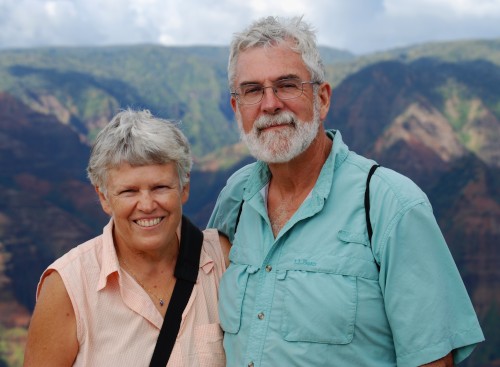
Who: Craig & Barbara Johnston
Port: Portland, Or
